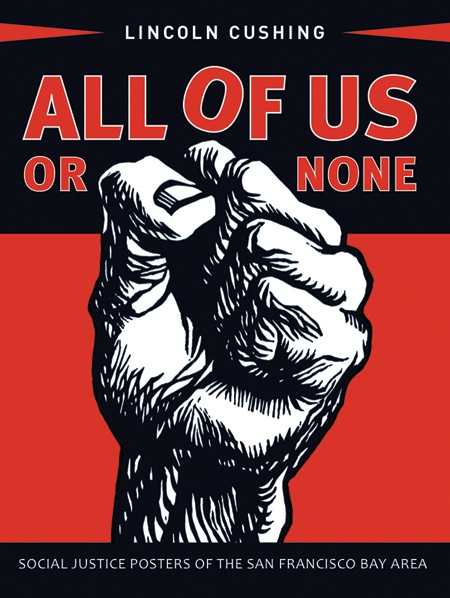
All of Us or None
Social Justice Posters of the San Francisco Bay Area
All of Us or None: Social Justice Posters of the San Francisco Bay Area takes us from the streets into the trenches of some of the twentieth century’s most vibrant social justice struggles: in the small print shops and art collectives producing the posters on display, passionate folks were making revolution as fast as the ink could dry.
The book explores the value of poster art in connecting people to social justice movements and seeks to establish legitimacy for these prints within the artistic cannon. Both “a tool for public democratic debate” and realistic fundraising opportunities for artists within low-income communities, art posters as a medium suit San Francisco’s reputation as a city where people speak up for themselves, and against the mainstream.
The collection is well organized in the style of exhibition catalogs (All of Us or None is on view at the Oakland Museum of California this summer): it flows fairly smoothly and chronologically from the “long 1950s” that laid the groundwork for an explosion of rebellion against conformity through to the modern era of digital typesetting and international solidarity in a global common struggle. Aiming “to gather a broadly representative sample of a vast, collective work of social art,” the book generally succeeds in providing examples of—and the context surrounding—a wide range of socially provocative prints.
Some of the most interesting and best-contextualized artworks appear in the chapters devoted to “The New Left” and to “Counterculture,” areas where the vast numbers of other local efforts intersected. Free speech, antiracism, feminist, and environmental activists leant valuable diversity to the antiwar poster culture. Later in the book, these and others (local Asian communities, disability activists) receive closer attention in the chapter entitled “Other Voices,” though the depth of their treatment leaves room for future, more focused, study.
Cushing’s inclusion of an appendix cataloguing the various printing houses and collectives that served and helped build numbers in the battle over the years is a boon to the book. Here, the art tradition and the sociopolitical climate fade slightly in favor of a gritty look at the nuts and bolts of getting the posters made and up on walls. And here, the social organizing aspect of the usually not-for-profit presses and workshops is allowed to shine, highlighting the thread of anonymity and collaboration that runs throughout the poster-making tradition. Art students and modern-day poster makers will find inspiration, while social historians are likely to learn something new about the iconic images of the last half-century.
Reviewed by
Patty Comeau
Disclosure: This article is not an endorsement, but a review. The publisher of this book provided free copies of the book to have their book reviewed by a professional reviewer. No fee was paid by the publisher for this review. Foreword Reviews only recommends books that we love. Foreword Magazine, Inc. is disclosing this in accordance with the Federal Trade Commission’s 16 CFR, Part 255.
